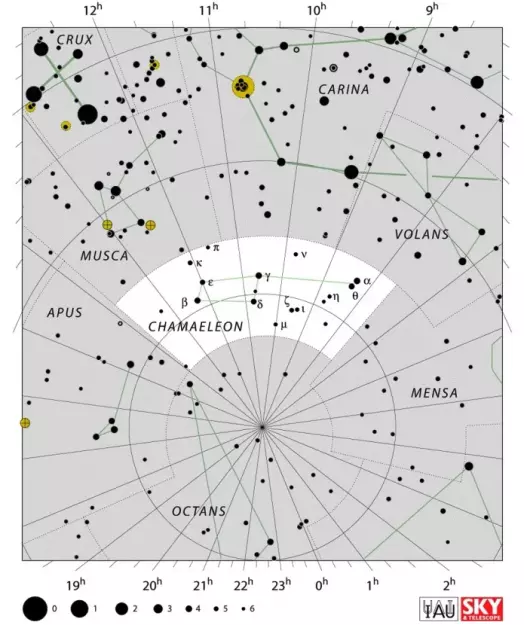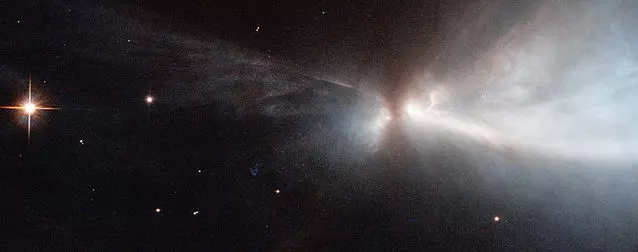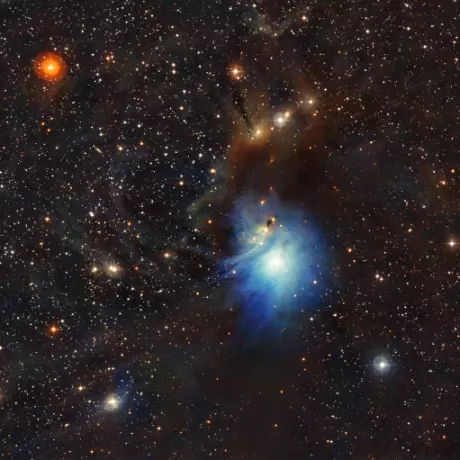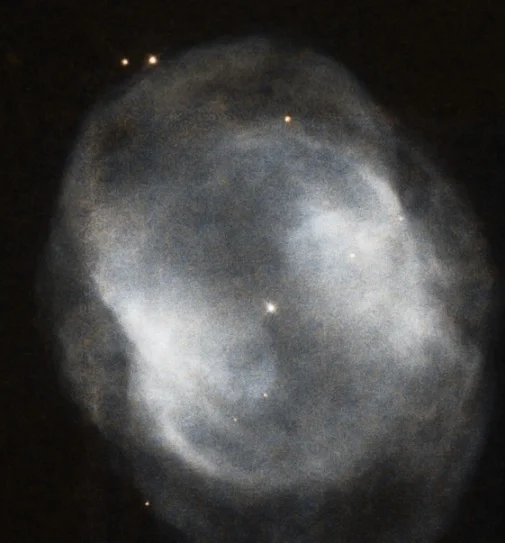Chamaeleon constellation is located in the southern sky. It was named after a type of lizard, the chameleon. The constellation was created by the Dutch astronomer Petrus Plancius from the observations of Dutch navigators Pieter Dirkszoon Keyser and Frederick de Houtman in the 16th century.
Chamaeleon was first depicted in Johann Bayer’s star atlas Uranometria in 1603. The constellation is sometimes also called the Frying Pan in Australia.
Notable deep sky objects in Chamaeleon include the planetary nebula NGC 3195, the Chamaeleon cloud complex, and the Eta Chamaeleontis Cluster. The constellation also contains Cha 110913 (or Cha 110913-773444), an astronomical object located at a distance of 163 light years from Earth, surrounded by what seems to be a protoplanetary disk. Astronomers are uncertain whether the object is a sub-brown dwarf with planets or a rogue planet with moons. Cha 110913 was discovered in 2004.
Facts, location and map
Chamaeleon is the 79th largest constellation in the sky, occupying an area of only 132 square degrees. It lies in the second quadrant of the southern hemisphere (SQ2) and can be seen at latitudes between 0° and -90°. The neighboring constellations are Apus, Carina, Mensa, Musca, Octans, and Volans.
The constellation name Chamaeleon is pronounced /kəˈmiːliən/. In English, the constellation is known as the Chameleon. The genitive form of Chamaeleon, used in star names, is Chamaeleontis (pronunciation: /kəˌmiːliˈɒntɪs/). The three-letter abbreviation, adopted by the International Astronomical Union (IAU) in 1922, is Cha.
Chamaeleon has one star with known planets and does not contain any Messier objects. The brightest star in the constellation is Alpha Chamaeleontis. Alpha Chamaeleontis is also the nearest star in Chamaeleon, located at a distance of 63.45 light years from Earth.
Chamaeleon does not have any stars brighter than magnitude 3.00 or located within 10 parsecs (32.6 light years) of Earth. There are no meteor showers associated with the constellation.
Chamaeleon contains one formally named star. The star name approved by the International Astronomical Union (IAU) is Ceibo (HD 63454).
Chamaeleon belongs to the Johann Bayer family of constellations, along with Apus, Dorado, Grus, Hydrus, Indus, Musca, Pavo, Phoenix, Tucana, and Volans.

Chamaeleon constellation map by IAU and Sky&Telescope magazine
Story
There are no myths associated with Chamaeleon constellation. It is one of the constellations charted by Dutch navigators in the 16th century and named after exotic animals by Plancius. In this case, the constellation was named after a lizard that changes colour to match the environment.
The Dutch cartographer Jodocus Hondius depicted the constellation as a chameleon sticking its tongue out to catch the fly represented by the neighboring constellation Musca.
Chamaeleon stars
α Chamaeleontis (Alpha Chamaeleontis)
Alpha Chamaeleontis is a star belonging to the spectral type F5III, approximately 63.5 light years distant. It has an apparent magnitude of 4.066. It is the brightest star in the constellation.
β Chamaeleontis (Beta Chamaeleontis)
Beta Chamaeleontis is a main sequence star belonging to the spectral class B5Vn. Its apparent magnitude varies from 4.24 to 4.30. It is approximately 270 light years distant. Beta Chamaeleontis is the third brightest star in the constellation, after Alpha and Gamma Chamaeleontis.
δ1 Chamaeleontis (Delta-1 Chamaeleontis)
Delta-1 Chamaeleontis is a close binary star composed of two similar stars separated by 0.6’’.
ε Chamaeleontis (Epsilon Chamaeleontis)
Epsilon Chamaeleontis is another close binary, with two stars separated by 0.9”.
R Chamaeleontis
R Chamaeleontis is a Mira-type variable star with a period of 334 days. Its apparent magnitude varies from 7.5 to 14.
CT Chamaeleontis
CT Chamaeleontis is a T Tauri star with an apparent magnitude that varies between 12.31 and 12.43. It is approximately 540 light years distant. The star has a faint companion, CT Chamaeleontis b, believed to be a brown dwarf.
HD 63454
HD 63454 is a K-type main sequence star with an apparent magnitude of 9.40. It is approximately 116.7 light years distant. It lies near the south celestial pole and can be seen in a small telescope. The star is slightly cooler and less luminous than the Sun. In February 2005, a hot Jupiter-like planet, HD 63454 b, was discovered orbiting the star.
Deep sky objects in Chamaeleon
Eta Chamaeleontis Cluster
Eta Chamaeleontis Cluster, also known as Mamajek 1, is an open star cluster centred on the star Eta Chamaeleontis. It is approximately 316 light years distant and believed to be around eight million years old. The cluster was discovered in 1999. It consists of 12 or so relatively young stars – their approximate age is eight million years – and seems isolated, without any star forming gas clouds nearby. Eta Chamaeleontis Cluster was the first open cluster discovered because of the X-ray emissions from its member stars.
Chamaeleon cloud complex
Chamaeleon constellation contains a number of molecular clouds, located between 400 and 600 light years from the solar system.
The clouds are forming low-mass T Tauri type stars. The most notable cluster of such stars, as well as young B-type stars, lies in the Chamaeleon I cloud, close to the reflection nebula IC 2631.

This striking new image, captured by the NASA/ESA Hubble Space Telescope, reveals a star in the process of forming within the Chamaeleon cloud. This young star is throwing off narrow tails of gas from its poles — creating this ethereal object known as HH 909A. These speedy outflows collide with the slower surrounding gas, lighting up the region. When new stars form, they gather material hungrily from the space around them. A young star will continue to feed its huge appetite until it becomes massive enough to trigger nuclear fusion reactions in its core, which light the star up brightly. Before this happens, new stars undergo a phase during which they throw bursts of material out into space. This material is ejected as narrow jets that streak away into space at breakneck speeds of hundreds of kilometres per second, colliding with nearby gas and dust and lighting up the region. The resulting narrow, patchy regions of faintly glowing nebulosity are known as Herbig-Haro objects. They are very short-lived structures, and can be seen to visibly change and evolve over a matter of years (heic1113) — just the blink of an eye on astronomical timescales. Image: NASA & ESA; acknowledgements: Kevin Luhman (Pennsylvania State University), and Judy Schmidt
Chamaeleon I is relatively isolated from other molecular clouds. It is one of the nearest star forming regions known. It contains about 200-300 stars and 70-90 X-ray sources.

A newly formed star lights up the surrounding cosmic clouds in this image from ESO’s La Silla Observatory in Chile. Dust particles in the vast clouds that surround the star HD 97300 diffuse its light, like a car headlight in enveloping fog, and create the reflection nebula IC 2631. Although HD 97300 is in the spotlight for now, the very dust that makes it so hard to miss heralds the birth of additional, potentially scene-stealing, future stars. Image: ESO
The Chamaeleon II cloud has about 40 X-ray sources.
Chamaeleon III is not believed to have any star forming activity occurring in it.
NGC 3195
NGC 3195 is a bright planetary nebula in Chamaeleon. It lies halfway between the stars Delta and Zeta Chamaeleontis and is the southernmost bright nebula known. It cannot be seen from the northern hemisphere at all.
The nebula was discovered by Sir John Herschel in 1835. It has an apparent magnitude of 11.6 and is approximately 5,500 light years distant.

The planetary nebula NGC 3195, image: Judy Schmidt (CC BY 2.0)